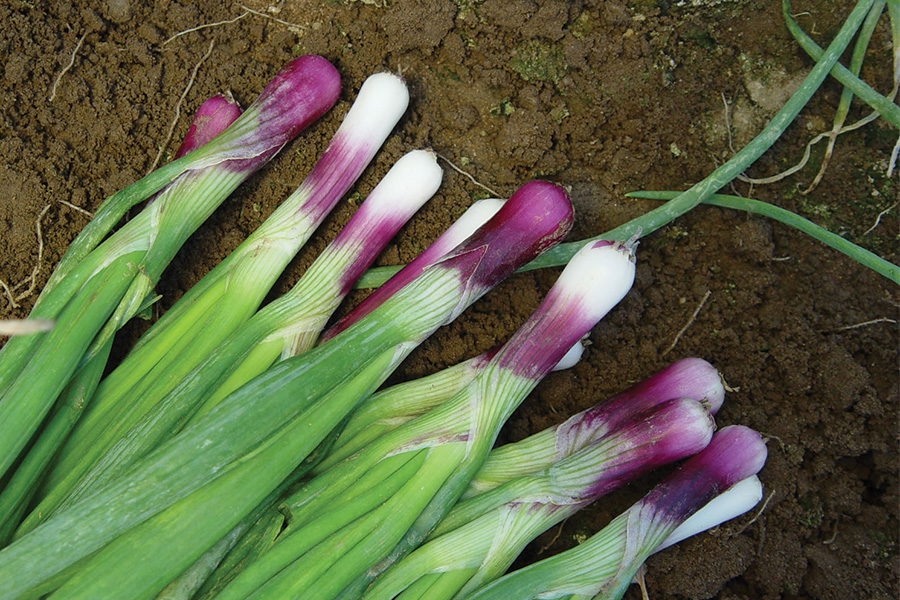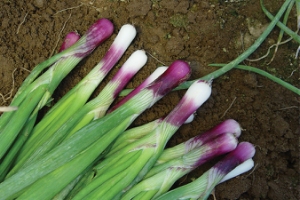
Red Bunching (DPS 3047)
A hybrid, red skinned, white fleshed bunching onion with an attractive deep color. This onion makes a striking presentation in the market.
| V34036 : Red Bunching (DPS 3047) | ||
|---|---|---|
| Treatment | * Pkg Size | ** Price (USD) |
| Treated | 5M seeds | $41.25 |
| Treated | 25M seeds | $171.25 |
| Treated | 100M seeds | $505.00 |
|
* M = 1,000 ** US customer prices shown in USD. *** Canadian customers, please log in to see CA prices in USD. |
||
Attributes
Growing Tips
- Planting
-
Onions are mostly direct seeded in the field, although some are transplanted as seedlings or sets. Transplants are sometimes used to improve bulb size, as well as to hasten maturity, or to avoid infection by some plant diseases, but this method of crop establishment is more expensive. Planting occurs from late March through early May. Between-row spacing varies considerably depending upon weed and foliar disease management, seeder capability, and harvesting equipment. In-row spacing also varies depending upon variety, desired bulb size, between row spacing, soil type, and other management considerations.
Bunching Onions - Direct seed in spring when the soil reaches 50°F. Plant seed ¼” deep and approximately ½” apart.
Bulb Onions/Short Day - Typically short day onions are direct seeded in the southern region of the United States. In order to grow short day onions in the northern region of the United States the seed has to be sown in greenhouses and then transplanted into the field. Use pelleted seed if direct seeding to help achieve better singulation.
Bulb Onions/Intermediate Day - Direct seed intermediate day onions as soon as soil allows in April or early May. Sow seed 2” apart and thin to 3 - 4” apart for larger onions. Seeding depth should be approximately ¼” deep. If transplanting seed in flats in late February to mid March, tops may be clipped to 5” tall. Use pelleted seed if direct seeding to help achieve better singulation.
Bulb Onions/Long Day - Direct seed long day onions as soon as soil allows in April or early May. Sow seed 2” apart and thin to 3 - 4” apart for larger onions. Seeding depth should be approximately ¼” deep. If transplanting seed in flats in late February to mid March, tops may be clipped to 5” tall. Use pelleted seed if direct seeding to help achieve better singulation. Plant long day onions in the northern latitudes.
Planting Guidelines - OnionApproximate Seeds per Pound:106,000 - 144,000Seeding Rate per Acre by Weight:1.4 - 1.4 lbsSeeding Rate per Acre in M (1,000):163.3 - 204.2 MSeeding Rate Seeds per 1,000 foot of Row:6,000Seed or Plant Spacing In Row:2"Seed or Plant Spacing Between Rows:16 - 20"Seed or Plant Spacing Depth:.5"Recommended Soil Temperature:32 - 85°FDays to Germination:10 - 14
- Management
-
Keep onions well weeded with shallow cultivation. Onions are shallow rooted and grow best in moist soil; irrigation may be required. Keep direct seeded onions away from onion sets because onion sets are more prone to disease. Long day onions should be planted in northern latitudes because of daylight requirements for bulbing.
- Harvest
-
Onions are ready to harvest when tops approximately have 50 - 75% fallen over and the skins have dried. Pull the bulbs by hand or use equipment such as a potato digger or undercutter to cut the roots and lift the bulbs. Wait until all the leaves are dead and dry. It is likely the outer skins will loosen. Pulling onions too green will make them difficult to cure and will affect storing them. Harvest when the weather is dry.
- Storage
-
Cure onions at 65 - 85°F at 70% humidity. Curing decreases the incidence of neck rot, reduces water loss during storage, prevents microbial infection, and is desirable for development of good scale color. Curing can be done in the field, preferably when the weather is warm and dry. If it rains let them dry fully before handling. A greenhouse or hoophouse also provides good conditions for curing. Temperatures in the 80’s will enhance the bronze color in the skins. Sunshine is good as long as it is not too hot. Extreme sun can produce sunscald. Store onions out of the sun; exposure to light after curing will induce greening of outer scales. Optimum temperature for long term storage of onions is 32°F with 65 - 70% humidity. It is important to cool them down slowly. Using cool late summer and fall temperatures works great to cool onions down slowly.

